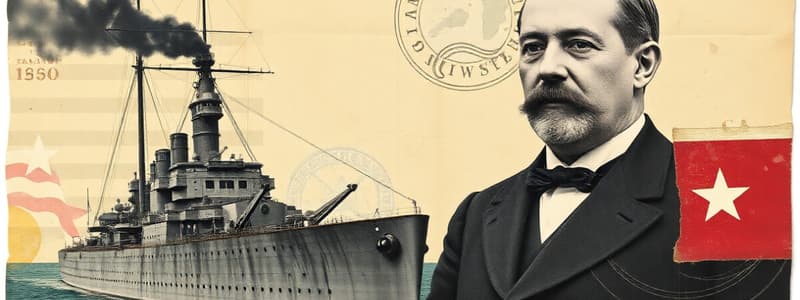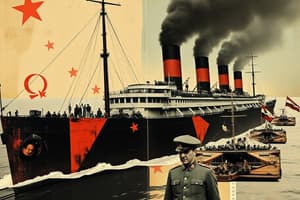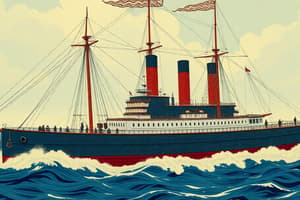Podcast
Questions and Answers
What event served as the primary catalyst for the Spanish-American War, escalating tensions between the United States and Spain?
What event served as the primary catalyst for the Spanish-American War, escalating tensions between the United States and Spain?
The explosion of the battleship Maine in Havana Harbor.
What role did the American press play in the lead-up to the Spanish-American War?
What role did the American press play in the lead-up to the Spanish-American War?
The U.S. press stirred up American sentiment.
What actions did President McKinley take in response to Spain’s rejection of U.S. demands regarding Cuba?
What actions did President McKinley take in response to Spain’s rejection of U.S. demands regarding Cuba?
He ordered a naval blockade of Cuba and issued an order for the call-up and deployment of 125,000 military personnel.
What famous order did Commodore George Dewey give at the Battle of Manila Bay, marking the beginning of the engagement?
What famous order did Commodore George Dewey give at the Battle of Manila Bay, marking the beginning of the engagement?
What was the significance of the Treaty of Paris, signed on December 10, 1898, in relation to the Spanish-American War?
What was the significance of the Treaty of Paris, signed on December 10, 1898, in relation to the Spanish-American War?
What territories did the United States gain control over as a result of the Treaty of Paris following the Spanish-American War?
What territories did the United States gain control over as a result of the Treaty of Paris following the Spanish-American War?
What strategic advantage did the United States gain that would link the Atlantic and Pacific oceans as a result of the Spanish-American War?
What strategic advantage did the United States gain that would link the Atlantic and Pacific oceans as a result of the Spanish-American War?
Beyond acquiring territories, how did the Spanish-American War shift the United States’ position in global affairs?
Beyond acquiring territories, how did the Spanish-American War shift the United States’ position in global affairs?
What specific tactical objective did Dewey achieve after destroying the Spanish squadron?
What specific tactical objective did Dewey achieve after destroying the Spanish squadron?
How did the U.S. Navy's blockade of Santiago Bay contribute to the overall outcome of the war?
How did the U.S. Navy's blockade of Santiago Bay contribute to the overall outcome of the war?
What was the role of the French ambassador, Jules Cambon, in the conclusion of the Spanish-American War?
What was the role of the French ambassador, Jules Cambon, in the conclusion of the Spanish-American War?
Why was the capture of Manila significant in the Spanish-American War?
Why was the capture of Manila significant in the Spanish-American War?
What U.S. Navy ships were involved in the Asiatic Squadron's defeat of the Spanish squadron at Manila Bay?
What U.S. Navy ships were involved in the Asiatic Squadron's defeat of the Spanish squadron at Manila Bay?
Name two admirals that were in command of the U.S. Navy that successfully blockaded the port of Santiago.
Name two admirals that were in command of the U.S. Navy that successfully blockaded the port of Santiago.
What was the main goal of the Cuban revolutionaries in the years leading up to the Spanish-American War?
What was the main goal of the Cuban revolutionaries in the years leading up to the Spanish-American War?
What specific action did the U.S. Congress take on April 20th related to Cuba, just before the Spanish-American War?
What specific action did the U.S. Congress take on April 20th related to Cuba, just before the Spanish-American War?
Besides military gains, what non-contiguous territory did the United States annex as a result of the Spanish-American War period?
Besides military gains, what non-contiguous territory did the United States annex as a result of the Spanish-American War period?
Who was the Spanish Admiral that attempted to evade the U.S. blockade of Santiago harbor?
Who was the Spanish Admiral that attempted to evade the U.S. blockade of Santiago harbor?
What was the name of the U.S. Secretary of the Navy who ordered Admiral William Sampson to create the Eastern Squadron?
What was the name of the U.S. Secretary of the Navy who ordered Admiral William Sampson to create the Eastern Squadron?
What role did the report by the U.S. Naval Court of Inquiry play in influencing public sentiment and governmental actions related to the USS Maine?
What role did the report by the U.S. Naval Court of Inquiry play in influencing public sentiment and governmental actions related to the USS Maine?
Flashcards
Spanish-American War
Spanish-American War
Conflict in 1898 between Spain and the United States.
Battleship Maine
Battleship Maine
U.S. battleship that exploded in Havana Harbor in February 1898, killing 266 American sailors.
Cuba's Independence
Cuba's Independence
A joint resolution passed by Congress acknowledging Cuba's independence and demanding that Spain relinquish control of the island
Dewey's Famous Order
Dewey's Famous Order
Signup and view all the flashcards
Asiatic Squadron
Asiatic Squadron
Signup and view all the flashcards
Patricio Montojo
Patricio Montojo
Signup and view all the flashcards
Santiago Blockade
Santiago Blockade
Signup and view all the flashcards
William T. Sampson and Winfield S. Schley
William T. Sampson and Winfield S. Schley
Signup and view all the flashcards
Guantanamo Bay
Guantanamo Bay
Signup and view all the flashcards
Battle of San Juan Heights
Battle of San Juan Heights
Signup and view all the flashcards
Pascual Cervera y Topete
Pascual Cervera y Topete
Signup and view all the flashcards
Treaty of Paris (1898)
Treaty of Paris (1898)
Signup and view all the flashcards
Guam, Puerto Rico, Philippines
Guam, Puerto Rico, Philippines
Signup and view all the flashcards
US as Pacific Power
US as Pacific Power
Signup and view all the flashcards
Study Notes
Spanish-American War
- Took place in 1898
Background
- Preceded by three years of Cuban revolutionaries fighting for independence from Spanish rule
- The conflict in Cuba garnered American public attention from 1895-98 because of economic and political instability near the US
- The U.S. press and politicians played a role in inciting American sentiment
Key Events of 1898
- Tensions between the U.S. and Spain increased
- The Battleship Maine exploded in Havana harbor on February 15, sinking it
- 266 American sailors died when Battleship Maine exploded
- This event increased the likelihood of U.S. military intervention in Cuba
- On April 20, Congress recognized Cuba's independence through a joint resolution
- Congress demanded Spain relinquish control of Cuba
- President William McKinley was authorized to use necessary military measures to guarantee Cuba's independence
- Spain rejected U.S. demands and severed diplomatic ties
- McKinley ordered a naval blockade of Cuba
- McKinley called up 125,000 military personnel, termed "volunteers"
Naval Engagements
- The first battle occurred on May 1
- Commodore George Dewey ordered, "You may fire when you are ready, Gridley."
- The Navy's Asiatic Squadron defeated the Spanish squadron defending Manila Bay in six hours
- Spanish Admiral Patricio Montojo y Pasaron commanded the Spanish squadron
- The Asiatic Squadron included cruisers Olympia, Raleigh, Boston, and Baltimore
- It also included gunboats Concord and Petrel, revenue cutter McCulloch
- Reinforcements came from cruiser Charleston and monitors Monadnock and Monterey
- The Asiatic Squadron forced Manila's surrender
- The entire Spanish squadron was sunk, including cruisers Maria Cristina and Castilla and gunboats Don Antonio de Ulloa, Don Juan de Austria, Isla de Luzon, Isla de Cuba, Velasco, and Argos
Capture of Manila
- Dewey silenced enemy shore batteries
- 11,000 U.S. troops arrived under U.S. Army Major General Wesley Merritt
- Manila fell by August 13
Cuba
- Admiral William T. Sampson and Admiral Winfield S. Schley successfully blockaded the port of Santiago on May 27
- U.S. Marines landed on Guantanamo Bay
- Additional forces landed near Santiago in late June
- U.S. ground forces defeated the Spanish army at the Battle of San Juan Heights from July 1-3
- Admiral Pascual Cervera y Topete attempted to break the U.S. blockade of Santiago harbor
- The U.S. naval forces destroyed his squadron
- American ships destroyed Spanish destroyer Furor, torpedo boat Pluton, and armored cruisers Infanta Maria Teresa, Almirante Oquendo, Vizcaya, and Cristobal Colon
- The Spanish lost all ships, 350 killed, 160 wounded
End of War
- The war was almost over due to U.S. military dominance
- Spain was unprepared for war with the U.S.
- The French ambassador in Washington, Jules Cambon, approached the McKinley administration to discuss peace terms on July 26
- A cease-fire was signed on August 12
- The war officially ended with the Treaty of Paris, signed by the U.S. and Spain on December 10, 1898
Outcomes
- Spain's colonial empire in the western hemisphere ended
- The U.S. became a Pacific power
- Spain relinquished claims on Cuba
- Spain ceded sovereignty over Guam, Puerto Rico, and the Philippines, with the U.S. paying $20 million for the latter
- The U.S. annexed Hawaii
- The U.S. established its predominance in the Caribbean
- The U.S. pursued strategic and economic interests in Asia
- The construction of the Panama Canal was enabled, which linked the Atlantic and Pacific Oceans
Key Dates
- February 15: Battleship Maine exploded in Havana Harbor, Cuba, killing 266 American sailors
- March 28: A U.S. Naval Court of Inquiry reported the Maine explosion was caused by a mine
- April 4: The New York Journal dedicated a million-copy press run to the war in Cuba, calling for U.S. entry into the war
- April 22: President William McKinley ordered a blockade of Cuba and suspended diplomatic relations
- April 24: Spain declared war against the United States
- April 25: Congress declared a state of war existed since April 21
- May 1: Battle of Manila Bay where Commodore George Dewey’s Asiatic Squadron destroyed the entire Spanish squadron
- May 10: Secretary of the Navy John D. Long ordered Captain Henry Glass to capture Guam on the way to Manila
- May 27: Blockade of the port of Santiago de Cuba by the U.S. Navy under Admiral William Sampson and Admiral Winfield Schley
- June 10: U.S. Marines landed at Guantanamo, Cuba
- June 18: U.S. Secretary of the Navy John D. Long ordered Admiral William Sampson to create a new squadron, the Eastern Squadron
- June 20: Spanish authorities surrendered Guam to Captain Henry Glass and cruiser Charleston
- June 20: Main U.S. force appeared off Santiago de Cuba
- June 22: U.S. troops landed at Daiquiri, Cuba
- July 1–3: Battle of San Juan Heights
- July 3: The Spanish fleet tried to escape Santiago Bay but were repulsed
- July 17: The Spanish surrendered to the United States at Santiago
- August 12: The United States and Spain signed the Protocol of Peace, ending hostilities
- December 10: A Treaty of Paris was signed by representatives from the U.S. and Spain
- December 23: Guam was placed under the control of the U.S. Department of the Navy
- February 6, 1899: The Treaty of Paris was ratified by the U.S. Senate where the U.S. acquired control of Cuba, Puerto Rico, Guam, and the Philippines
Studying That Suits You
Use AI to generate personalized quizzes and flashcards to suit your learning preferences.




